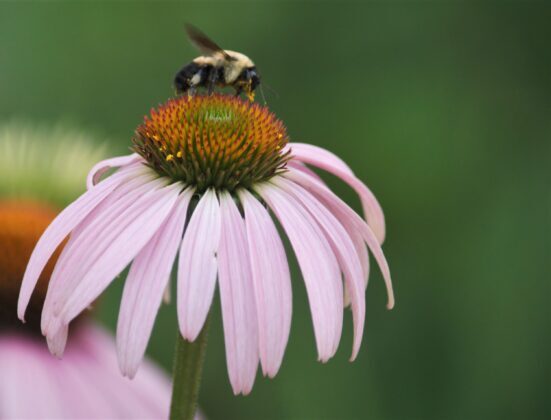“Our worsening droughts and our catastrophic floods are characteristic fingerprints of human interference, a record of our post-industrial existence etched in the water flows of the planet. Attribution science has now advanced so much that we can quantify the human contribution to individual downpours and droughts.”
– Kate Marvel,
“Droughts and Floods,”
from The Climate Book
What you’re looking at is Echinacea (coneflower) planted on Wells Street next to the MDC building as part of their demonstration sustainable rain gardens.
![]()
Don’t know what rain gardens are? With all the talk of flooded basements in the northern section of Hartford and with the dramatic photos of West Hartford’s streets flooded above car rims, it’s time that we all became more personal with green infrastructure, which includes but is not limited to rain gardens.
We’re starting here because rain gardens and bioswales are the sexiest of the green infrastructure.
The two are technically different, but I am going to use the terms interchangeably, and if you decide to install one, you can do the legwork to determine the slight difference in design.
Let’s just start with this: you never read headlines about people rescuing ducks/baby raccoons/chonky cats from rain gardens. It’s not a feature they can get stuck in.
Fact: Stephen King’s killer clown, It, was in a storm drain. It wasn’t lurking in a rain garden.
I’m not saying we should abolish storm drains, but we should reconsider our overreliance on them.
How many people remove the litter that accumulates on storm drain grates? How many do this before the road starts flooding?
Rain gardens are not immune to gathering litter, but there’s much more forgiveness before they lose their functionality.
So, what’s the purpose?
Flowers need no occasion.
But if you’re a grouch who needs functionality, rain gardens, done right, are a multi-tool.
They help to reduce the severity of flash flooding. Notice that I did not say prevent or eliminate. Thanks to our jetsetting, drive-thru, drive everywhere, pave the planet ways, the climate has changed. While we work on reducing future damage and figuring out how to undo any of this, we have to mitigate, or lessen, the effects.
Water wants to soak into the ground. Because we’ve paved just about everything, it can’t do so easily. It’s going to roll downhill when possible and pond/pool when not. Better a grass lawn than a paved front yard, but better than that is to have a variety of plants with more complex root structure.
There’s a reason for having a rain garden, then, in place of either paved or plain grass (Bermuda grass) curb strips — and also these cool features can go elsewhere, not just along the sidewalk.
Besides reducing flash flood impacts, rain gardens help filter nasty chemicals out of the water. You know how sometimes after heavy rainstorms we hear about various beaches and swimming holes being closed? This is why: when runoff isn’t filtered and ends up in a larger body of water, downhill. Usually it only takes a few days to clear up, but I have trouble accepting this as just the way things are when it is a thing we can change.
To recap: aesthetics, reduced flooding, water filtering.
There’s at least one more advantage: if native plants are chosen for these spots — and really, they should be — the rain garden doubles as a pollinator garden. Purple coneflower is native to this region, as is Swamp milkweed, New England aster, New York ironweed, and a lot more.
Besides the initial cost and a little maintenance for the first two years while plants get established, there really aren’t downsides to having rain gardens, which makes me wonder why we aren’t seeing a new one of these show up every month in Hartford.
Every year the Wadsworth Atheneum holds its Fine Art & Flowers weekend exhibit, which is extremely well-attended. I would like to see Hartford’s local artists expand their range and get into more non-toxic public art pieces, like creatively arranged plantings in rain gardens citywide. Grant funded functional art installations. How about that?
Climate Possibilities is a new series about climate mitigation, along with resilience, resistance, and restoration. It’s about human habitat preservation. It’s about loving nature and planet Earth, and demanding the kind of change that gives future generations the opportunity for vibrant lives. Doomers will be eaten alive, figuratively. All photographs are taken in Hartford, Connecticut unless stated otherwise.

